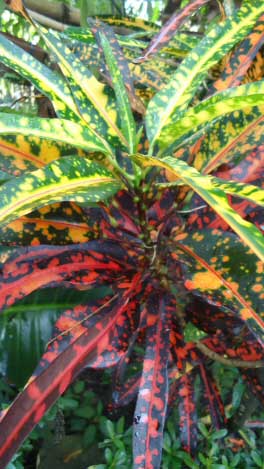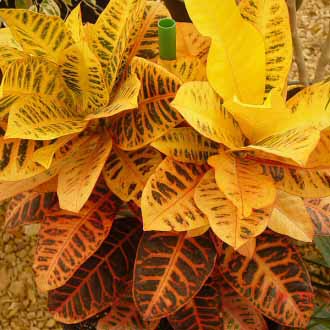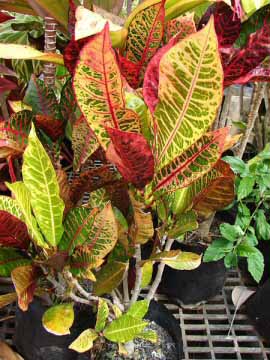





The Croton is a difficult diva of a houseplant to have in your home. There we've said it. Grown outside in its native country of Sri Lanka it's much easier, but indoors it's incredibly temperamental and will not accept poor treatment for very long.  But if you work with it, the Croton is a work of art and can be an extraordinarily showpiece. Our article will give you top tips and care instructions to keep yours looking splendid.
But if you work with it, the Croton is a work of art and can be an extraordinarily showpiece. Our article will give you top tips and care instructions to keep yours looking splendid.
We don't recommend the Croton, or any Codiaeum plants, for the beginner because grown as a houseplant they are a challenge. It's sometimes hard to look after and can be a real bind to even try and find someone who is selling it, but a challenge is sometimes a good thing. (Like growing a Bird of Paradise from seed and having to wait 5 years for it to flower for the first time). Finally the last obvious negative point is its family connection with Euphorbia. Possibly the most famous plant family for being mildly poisonous and an irritant to humans and animals. That said keep the plant out of reach of pets and children and avoid contact with the latex sap it produces when the leaves are cut or damaged and disaster will be avoided.
The leaves are stunning, unique and brilliant. There are several different Croton varieties and cultivars you can find with a good four or five different leaf shapes available. They vary in colour and shape, wide, narrow, lobed or whole are all attainable. The leaves tend to feel like leather or waxy with a shine that emphases the colours that they come in, ranging from yellow, green orange to dark purple. The leaf patterns are often also mixed in some way, spotted, veined, striped or speckled which is the reason for its common name of Joseph's Coat.  What's most interesting of all perhaps is that everything on the plant (except the actual leaf shape), can be a random mix up. This means it's possible to find Crotons which have one colour at the top and totally different at the bottom. See the photo above to get an idea of this.
What's most interesting of all perhaps is that everything on the plant (except the actual leaf shape), can be a random mix up. This means it's possible to find Crotons which have one colour at the top and totally different at the bottom. See the photo above to get an idea of this.
This huge range makes it really, really difficult to know exactly what varieties or cultivar you actually have. Even if the pots are labeled they may be incorrect, so when you choose your plant it's probably best to look for a healthy one and use your eyes. Pick the plant you like visually rather than searching for specially named varieties, once your eyes have chosen and you cast them down to the labels, names such as Codiaeum reidii, C 'Eugene Drapps', C. holufiana, C. 'Geduldig', C. 'Goldfinger' and C. 'Norma' are all common.
Light
Good bright light is a compulsory requirement for a healthy Croton plant. You'll need to avoid really hot direct sunlight to prevent leaf scorching, but never provide low light conditions for long periods otherwise the leaf markings will fade.
Watering
Another very important Croton care instruction is watering. Too little and the leaves will fall and too much will cause a similar effect. You need the knack to get the balance right. Any experienced houseplant owner will know this instinctively, just by looking at their plant they can tell if it needs water. Beginners often don't and this is why watering mistakes are the top two reasons for plant death in general.
You want the soil to be evenly moist for the majority of the time.
So how do you water a Croton correctly? During growth, which tends to happen when conditions are warm, you want the soil to be evenly moist for the majority of the time. That's moist, not soggy, wet or saturated, equally as important, not dry. If you can pour water out of the pot, or there is wetness in the drip tray an hour after watering you're over doing it. If you let the soil dry out completely before you water again you are making the opposite mistake of under doing it. Some further problem symptoms of watering issues are covered in our help section below.
Humidity
Some people will say humidity isn't important or the leaves shouldn't be misted. We'd agree with the misting comments if conditions being provided are already very humid, i.e. you are growing a Croton in a terrarium or in a steamy bathroom. If you've opted for a dry, low humidity room you really need to be doing something to increase the humidity around the plant.
Feeding
Unlike many houseplants, Codiaeum's can be rather greedy with fertiliser and because they can grow quite quickly they need a reasonable amount. No need to over do it though, once a month or so at normal strength will be perfect.
Temperature
Crotons demand warmth, which is why problems are common when things turn chilly. 15°C / 50°F - is the minimum you will likely get away with assuming there are no draughts. However for growth and to play it safe you are looking for an average all year round temperature of 21°C / 70°F but warmer temperatures won't be a problem.
Repotting
All we can say about repotting is to be careful! So many people experience problems with leaf drop a few weeks after they repot their Crotons. Our experience has been more positive, but in this case it's best follow the traditional rule book and do it only in middle to late Spring. Try to use similar potting soil that is already around the current root ball. Don't cut or tease out the roots and handle it gently to minimize the risk of shock and causing the latex sap to bleed, wash your hands afterwards.
Propagation
Like the rest of the plant, propagating a Croton can be tricky. You can do it easy enough by creating a stem or "tip" cutting a few inches long, stripping back to just a few leaves, dipping into a rooting hormone and then pushing into everyday recently watered potting compost. The hard bit in all of this is what happens next, because even the young cuttings need warmth, and lots of it. Bottom heat is needed to trigger new roots to form and you're looking at a soil temperature of between 25°C - 30°C / 77°F - 86°F for this.
Speed of Growth
 Growth tends to be moderately fast, especially if it's being treated correctly.
Growth tends to be moderately fast, especially if it's being treated correctly.
Height / Spread
Small plant's are very much the norm, which may be because its hard to keep a Croton growing to a large size, however assuming you pull it off, yours could reach 5ft / 1.5m in height!
Flowers
You grow Codiaeum's for the foliage rather than its flowers, which is fortunate because this plant rarely flowers indoors.
Anything else?
Crotons are room enhancing plants when looking good. If they're treated poorly they're miserable things to have around on display. Whilst the majority of our article has the long term in mind, Crotons are quite cheap to buy, certainly less than a bouquet of flowers, so you can always look to enjoy it for a month or two before discarding if things don't work out.
Copyright © www.100flowers.win Botanic Garden All Rights Reserved